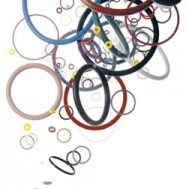When designing an o-ring for a specific application, material hardness plays an important role. Durometer, or Shore durometer, is a standardized device used to measure the hardness of polymers, elastomers, rubbers and plastics. When testing for hardness, a spring-loaded indenter is applied to penetrate through the specimen. The softer the material, the farther the indenter will penetrate.
Shore hardness is expressed by a number ranging from 0 to 100 on either a Shore A or Shore D scale. The higher the number on the scale, the harder the material. The major differentiation between the Shore A and Shore D is that Shore A is specified to measure flexible rubbers while Shore D is specified for harder, rigid materials. However, the ranges do tend to overlap at higher levels.
Measuring Shore A
Shore A hardness is measured based on ASTM D-2240 standards for cured rubber compounds, and ASTM D-1414 standards for finished o-rings. For ASTM D-2240 standards, the material thickness cannot be less than 0.24 inches.
When it comes to measuring Shore A, typical rubber seals fall within a specific range:
- 60 Shore A is softer, can stretch more easily and is better on rougher surfaces
- 70 Shore A is standard in terms of hardness for sealing devices
- 90 Shore A is very stiff and offers greater abrasion and extrusion resistance
ISO 48 standards are recommended when measuring hardness for softer materials, such as vulcanized rubber or thermoplastic. Softer Shore A materials are often used in delicate hardware applications or when minimum insertion force is required.
Examples of Shore A materials include:
- Rubber bands
- Automotive tire tread
- Wheels of roller skates
- Hydraulic o-rings
Measuring Shore D
The Shore D scale is used for harder materials such as plastics and ebonite. Similarly to Shore A, Shore D is measured based on ASTM D-2240 standards. However, Shore D is also measured according to ISO 868 standards, which can be divided into two types:
- Type A is used for softer materials
- Type D is used for harder materials
When durometer testing for Shore D, a hardened steel rod with a 30° conical point and 0.1 mm radius tip is used. This differs from Shore A durometer testing in which a truncated 35° cone with a 0.79 mm diameter is used. The difference in indenter sizes is based on the force required to penetrate the material. Shore A materials are softer and require less of a structured point to indent the material compared to Shore D materials.
Examples of Shore D materials include:
- Hard hats
- Solid truck tires
- Cast urethane plastic
Want to learn more about durometer testing for your o-ring?
Ask an engineer today.
